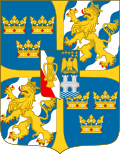Constitution
The non-noble Cap majority now proceeded to attack the Privy Council. the Riksrådet, the last stronghold of the Hats, and, on 25 April of that year, it succeeded in ousting them. It was now, for the first time, that Gustav began to consider the possibility of a revolution.
The new constitution of 20 August 1772 which Gustav III imposed upon the Riksdag of the Estates, converted a weak and disunited republic into a strong but limited monarchy. The estates could assemble only when summoned by him; he could dismiss them whenever he thought fit; and their deliberations were to be confined exclusively to the propositions which he laid before them. But these extensive powers were subjected to important checks. Thus, without the previous consent of the estates, no new law could be imposed, no old law abolished, no offensive war undertaken, no extraordinary war subsidy levied. The estates alone could tax themselves; they had the absolute control of the Riksbank – the Bank of Sweden, and the right of controlling the national expenditure.
In Sweden, the change was most popular. But Gustav's first Riksdag, that of 1778, opened the eyes of the deputies to the fact that their political supremacy had departed. The king was now their sovereign lord; and, for all his courtesy and gentleness, the jealousy with which he guarded and the vigour with which he enforced the prerogative plainly showed that he meant to remain so. But it was not till after eight years more had elapsed that actual trouble began. The Riksdag of 1778 had been obsequious; the Riksdag of 1786 was mutinous. It rejected nearly all the royal measures outright, or so modified them that Gustav himself withdrew them. When he dismissed the estates, the speech from the throne held out no prospect of their speedy revocation.
Nevertheless, within three years, the king was obliged to summon another Riksdag, which met at Stockholm on 26 January 1789. His attempt in the interval to rule without a parliament had been disastrous. It was only by a breach of his own constitution that he had been able to declare war against Russia in April 1788; the Conspiracy of Anjala (July) had paralysed all military operations at the very opening of the campaign; and the sudden invasion of his western provinces by the Danes, almost simultaneously (September), seemed to bring him to the verge of ruin. But the contrast, at this crisis, between his self-sacrificing patriotism and the treachery of the Russophil aristocracy was so striking that, when the Riksdag assembled, Gustav found that the three lower estates were ultra-royalist, and with their aid he succeeded, not without running great risks in crushing the opposition of the nobility by a second coup d'état on 16 February 1789 and passing the famous Act of Union and Security which gave the king an absolutely free hand as regards foreign affairs and the command of the army, and made further treason impossible. The nobility never forgave him.
Foreign affairs
Abroad, the Swedish revolution made a great sensation. Catherine II of Russia concluded a secret alliance with Denmark, in which the Swedish revolution was described as "an act of violence" justifying both powers in seizing the first favourable opportunity for intervention to restore the Swedish constitution of 1720.
Unknown to party leaders, Gustav had renewed the Swedish alliance with France and had received solemn assurances of assistance from Louis XV of France if Gustav were to reestablish monarchical rule in Sweden. Moreover, France agreed to pay its outstanding subsidies to Sweden, amounting to 1.5 million livres annually, beginning from January 1772. What's more, Charles Gravier, comte de Vergennes, was to be sent to Stockholm to circumvent the designs of Russia just as he had previously done in the Sublime Porte at Constantinople.







